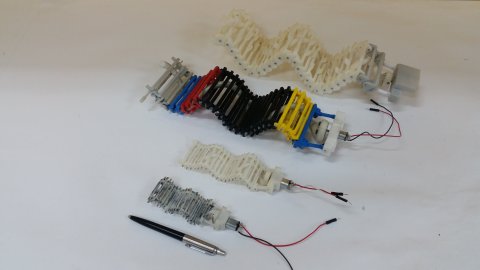It's estimated by the U.S. Centers for Disease Control and Prevention that some 23 million Americans have not been screened for colorectal cancer—and should be. A colonoscopy can catch cancer early and save lives, but people often do whatever they can to avoid the test because it's not a fun experience.
But that may change thanks to inchworms, wiggling bacterial organisms and snakes. David Zarrouk, a professor of mechanical engineering at Ben-Gurion University in Israel, is developing a miniature bio-inspired robot that will have the ability to crawl through the intestinal tract. The single actuator wave—or SAW—robot mimics the mechanical locomotion of these creatures, in particular the wave-like crawl that's likely to be an effective way to move through the digestive system. This could make both a colonoscopy and an endoscopy less invasive, eliminate the need for anesthesia and make cancer screening kind of cool.

"Colonoscopy is very uncomfortable for patients, and small robots would not do much harm," says Zarrouk.
The patient would swallow the robot equipped with a tiny camera, which is encased in a non-dissolving capsule. It would then move through the body and transmit high-quality images of the patient's innards that a doctor could view in real time. Zarrouk says the device has the ability to travel through the entire intestinal system in less than six minutes, moving more than 1 centimeter per second until it's naturally eliminated by the body. Additionally, a joystick would provide a way for the doctor to speed up or slow down the crawling robot.
Gastroenterologists like Dr. Seth Gross, an associate professor of medicine at New York University's Langone Medical Center, are already using the PillCam, a capsule-like medical imaging device that a patient swallows. The problem, though, is that the PillCam, developed by another group of researchers in Israel, simply moves through the body at the rate of digestive motility, which varies from patient to patient and may result in images that can't be used for diagnostic purposes. "If he and his team are really able to shrink that technology down to safely move through the small intestines and allow the physician to control it, that would be a tremendous step forward," says Gross.
The smallest model Zarrouk has made measures 4 inches, but it needs to be about half that size to make it ingestible. He thinks his lab can accomplish this in about two years. At that point, he'll turn the design over to a company to manufacture the bots for testing on pigs, which have intestinal tracts similar in size to human tracts.
The largest model he's made—around 10 inches long—moves well on hard terrain, such as his lab's floor and outdoors. It also can climb vertically between walls, navigate up or down steep hills and swim through water. "We found it could maybe be used as a search and rescue robot, so now we're developing another version," he says. But intestines are the ultimate challenge. "When you put the robot on a slippery, flexible surface, it sometimes gets stuck."





















